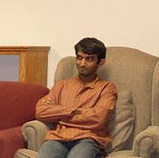Welcome to Tracking on Caffeine's homepage on the web!
This page documents the progress and final deliverables of Christine Toh and Nurali Virani's Advanced Mechatronics final project.
|
Nurali Virani
|
The Goal:
To track the movement of multiple objects as they move in front and behind each other. The challenge comes from fact that an object moving behind another object is obscured from the view of traditional LIDAR tracking, causing most algorithms to confuse the 2 objects as they pass each other. With the help of image detection using a camera, the identities of the 2 objects can be tested and updated, maintaining accurate tracking of the objects.
The Set-up:
The problem can be visualized as in the above image. The 'blind regions' of the LIDAR and Camera are depicted with green and red dotted lines respectively. As the blue object passes behind the red object, the identities of the individual objects become unknown to the LIDAR.
Using images from the camera, the identities of the objects can be distinguished using color information. Therefore, after the blue object passes behind the red object, the camera will be able to detect a blue and red object moving within the field. The order of these objects within the field will then be passed to the LIDAR. The original LIDAR tracking information will to be mapped to the camera location in order to receive accurate updates on object identities from the camera. The flow of the process is illustrated below.
Using images from the camera, the identities of the objects can be distinguished using color information. Therefore, after the blue object passes behind the red object, the camera will be able to detect a blue and red object moving within the field. The order of these objects within the field will then be passed to the LIDAR. The original LIDAR tracking information will to be mapped to the camera location in order to receive accurate updates on object identities from the camera. The flow of the process is illustrated below.



